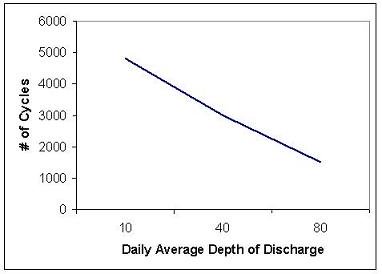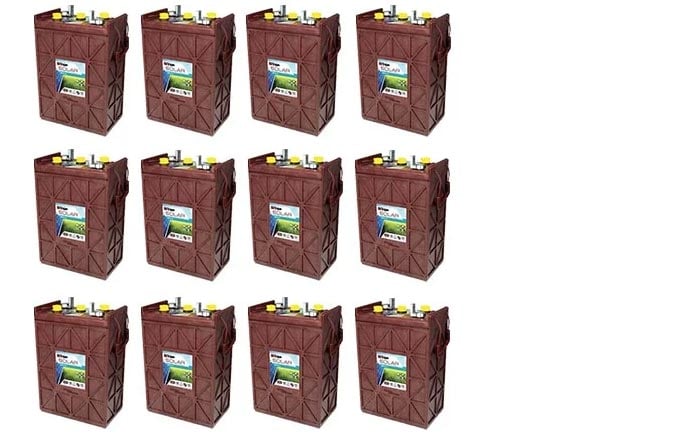- Photovoltaic or solar panels
- Wind power systems using wind turbines
- Hydroelectric generators
- Hybrid renewable energy systems
- Other power sources
The batteries used in renewable energy systems are deep cycle batteries. The energy they store can be used directly to power DC loads or it can be run through an inverter to power AC loads. To ensure you have enough reserve capacity to provide the electricity you need (without running additional generators), invest the time to size your deep cycle battery bank properly. Because of the various conditions affecting battery bank sizing, this process may be one of the more challenging calculations you’ll have to do when planning your RE system. Note that while expanding a deep cycle battery bank later is possible, it’s much better if you can avoid it by taking the time to properly size the bank from the start (this can mean oversizing it initially if your electricity use can be expected to grow in the coming years).
Before tackling the calculations, start by identifying a few key pieces of information:
- Watt-hour of electricity usage per day
- Number of Days of Autonomy
- Depth of Discharge limit
- Ambient temperature at battery bank
Electrical Usage
The first thing you’ll need to know is the amount of energy you’ll be consuming per day. It’s worth the time to do a careful evaluation of exactly what loads (appliances, electronics, etc.) you plan to use and for what lengths of time. Keep track of this information on a loads list; you’ll refer to this list often for sizing other components as well. Your final tally should be expressed in Watt-hours (Wh) per day. If you know the kilowatt hours (kWh) per day just multiply that number by 1,000 to determine the Watt-hours per day. (Example: 1.2 kWh = 1,200 Wh)
Days of Autonomy
Next, you must determine the number of days of battery back-up that you want to have on hand. In other words, if you are unable to charge your deep cycle batteries by any means, and you still need to draw power, you must provide this additional storage by increasing the size of your battery bank. For solar panel powered systems (PV), Days of Autonomy represents the number of cloudy days in a row that might occur and for which you intend to store energy. Consult a weather website, local meteorologist or even long-term area residents.
If you conclude that you need more then five days of battery backup, you may want to explore multiple sources of electricity generation or backup generator options (like a fossil-fueled generator). If your primary electricity source is wind power, determine the number of days when there is little or no wind. This information can be found in the data you’ve collected using your data-logging anemometer. Hydroelectric turbine systems are unique because they usually operate continuously, and therefore do not require extensive storage. If you’re sizing a battery bank to be used in conjunction with an on-demand fuel-powered generator, the number of days of backup will represent the number of days you wish to go without using your generator.
Depth of Discharge
Another factor to consider is the planned (DoD) of your deep cycle battery bank. Flooded lead acid batteries (FLA), sealed AGM batteries and sealed gel batteries are all rated in terms of charge cycles. A single cycle takes a battery from its fully charged state, through discharge (use), then back to full charge via recharging. The depth of discharge is the limit of energy withdrawal to which you will subject the deep cycle battery (or battery bank). DoD is expressed as a percent of total capacity. The further you discharge a battery, the fewer cycles that battery will be capable of completing. Simply stated, deeper discharge shortens battery life.

It’s recommended that you never discharge a lead-acid deep cycle battery below 50% of its capacity ; however, many battery manufacturers recommend even shallower DoDs. For off-grid applications, a 25% DoD will extend battery life significantly. On the other hand, if you’re only using the batteries occasionally, as a backup system, you can factor in a DoD of 50% or perhaps more.
Temperature
Deep cycle battery life and capacity are affected by temperature. Unlike PV modules, batteries perform best in moderate temperatures. In fact, the temperature standard for most battery ratings is 77° F. Cold temperatures tend to reduce battery capacity while high temperatures tend to shorten battery life. For this reason, people in colder climates will often find a place to keep their batteries indoors rather then leaving them subject to outside temperatures. FLA batteries can be destroyed in freezing temperatures. While sealed deep cycle batteries can operate in sub-freezing temperatures, their reserve capacities will be reduced substantially. Identify the lowest temperatures that the batteries will be exposed to and factor this into the calculation using the temperature table (below).
System Voltage
By this point, you will have identified your system voltage. This is typically 12V, 24V, or 48V.
Calculations
Once you’ve pinpointed all these variables, it’s time to calculate the size of your battery bank! Let’s go through the steps below, using the following example system:
- A system load of 6,000 Watt-hours per day
- Three days of autonomy (backup) needed
- Planned depth of discharge (DoD): 40%
- Battery bank ambient average low temperature 60°F
- A 48V system
| Step | Process | Example | ||||||||||||||||
|---|---|---|---|---|---|---|---|---|---|---|---|---|---|---|---|---|---|---|
| 1 | Identify total daily use in Watt-hours (Wh) | 6,000 Wh/day | ||||||||||||||||
| 2 | Identify Days of Autonomy (backup days); multiply Wh/day by this factor. | 3 Days of Autonomy: 6,000 x 3 = 18,000 Wh |
||||||||||||||||
| 3 | Identify Depth of Discharge (DoD) and convert to a decimal value. Divide result of Step 2 by this value. | 40% DoD: 18,000 / 0.4 = 45,000 Wh |
||||||||||||||||
| 4 | Derate battery bank for ambient temperature effect. Select the multiplier corresponding to the lowest average temperature your batteries will be exposed to. Multiply result from Step 3 by this factor. Result is minimum Wh capacity of battery bank:
|
60°F = 1.11 45,000 x 1.11 = 49,950 Wh |
||||||||||||||||
| 5 | Divide result from Step 4 by system voltage. Result is the minimum Amp-hour (Ah) capacity of your battery bank. | 49,950 / 48 = 1,040 Ah |
Selecting Deep Cycle Batteries to Meet the Amp-Hour Capacity
Now that you know the Amp-hour (Ah) capacity that will give you the storage you need, you may need a little guidance in selecting specific deep cycle batteries. Keep in mind that it’s best to keep the number of parallel strings of batteries to three or fewer. If you parallel more than three strings of batteries, you risk shortening battery life due to uneven charging1 . The ideal deep cycle battery bank has no parallel connections but is comprised of one or more series-connected batteries. Though parallel connections are not to be avoided at all cost, fewer such connections tends to reduce the chance of charging problems over time.
When batteries are cabled together in series, the voltage is additive. For example, you can put two 12V, 100 Ah batteries in series for a 24V bank. The capacity of that bank would still be 100 Ah. When batteries are connected in parallel, the voltage remains constant and the Ah capacity is additive. In our example with the 12V, 100 Ah batteries, connecting them in parallel would result in a 12V system with a capacity of 200 Ah.
The deep cycle batteries you select must meet both your system voltage requirements AND the Ah capacity you calculated. In our example of the 48V system, we calculated that we needed 1,040 Ah to produce 6,000 Wh per day with 3 days of storage. More than one configuration of batteries can meet this need. For example, you could have four 12V batteries in series, each with a capacity of 1,040 Ah or more. Or you could use eight 12V batteries wired in two parallel strings where each battery had a 520 Ah capacity. Or you could use twelve 2V batteries in series, again with appropriate Ah capacities. In any given case, there may be multiple solutions. Your choices will be limited by battery availability and budget.
Building the Battery Bank: Amps, Then Volts
To build your bank, try first to select a deep cycle battery that is rated close to the Ah capacity you calculated in Step 5 above. Ignore voltage for a moment. If you can’t find one that’s very close, look for one that has a capacity either one-half or one-third your needed Ah figure. These fractions represent the number of series strings of such batteries you would need, in parallel, to complete your bank (1/2 = 2 strings, 1/3 = 3 strings). Once you find a candidate battery, divide your system voltage by the battery’s voltage. This will give you the number of such batteries you would need in each series string.
The total number of individual batteries you will need to complete your battery bank will be the product of the number of strings needed to meet your Ah requirement and the number of batteries per string needed to meet your system voltage requirement.
Total # batteries in bank = (# series strings) X (# batteries per string)
You can then compare your candidate battery banks against price, size and availability. You may want to talk with people who have used these batteries and learn what their experiences have been, compare warranties and advertised features, and finally buy the batteries you feel are best for you.
In any battery-based RE system, deep cycle batteries are a major component investment — second in cost only to the PV modules in most cases — and they are a critical part of the system. Careful planning and deep cycle battery selection is vital to ensure that your battery bank meets your needs and provides many hundreds or thousands of charge cycles. Take your time, run the numbers more than once, and you’ll avoid the worst pitfalls of RE system design.



